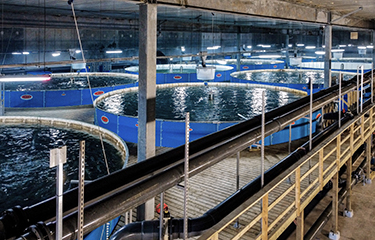An equipment failure at Sustainable Blue’s Nova Scotia, Canada-based recirculating aquaculture system in late November 2023 resulted in the loss of 20 percent of the company's Atlantic salmon.
Sustainable Blue CEO Kirk Havercroft told media the loss of the 100,000 or so fish may cost his firm as much as CAD 5 million (USD 3.7 million, EUR 3.4 million) and will leave it unable to supply customers until mid-2024.
Havercroft told SeafoodSource the incident was caused by the failure of a proprietary filtration system developed by the company to provide biological filtration and CO2 stripping.
“There was a structural collapse within the CO2 stripper itself,” he said. “As a result of that structural collapse, the system’s ability to remove CO2 was significantly compromised.”
The failure was so sudden, the company was unable to save the fish in the affected tank.
“We think it’s really important to differentiate between what I would consider to be a technology failure within a RAS system versus an acute sudden structural failure. These are two different things,” Havercroft said.
Havercroft remained bullish on the company’s future prospects, saying Sustainable Blue has developed a zero-discharge RAS that does not release any water back into the marine environment, allowing it to farm Atlantic salmon in salt water with much lower water use requirements than other systems that often require inflow and outflow pipes.
“It’s based on filtration principles, which have been conceived entirely by our own team,” Havercroft said. “Prior to the incident, the performance of the filtration technology has been absolutely faultless in its ability to remove waste, in its ability to operate in a zero-discharge configuration, in its ability to control not just solid waste removal but all dissolved organic material, and the removal of CO2.”
The equipment needed few “post-commissioning tweaks” after it was installed, proving that Sustainable Blue’s base technology is sound, Havercroft said.
“For us, the underlying performance of the technology was proven, this building was operating at full maximum design load,” he said. “What happened doesn’t at all indicate a technological weakness. It was a structural failure, which having identified the cause, is perfectly fixable. It was just extremely unfortunate that we have this incident so close to hitting maximum production.”
At its theoretical maximum production, Sustainable Blue's farm is capable of producing 40,000 pounds of whole round fish each week, which it achieved for the first time in October prior to the accident.
“We passed that test. We did better than we expected to,” Havercroft said. “We were really bearing down on being a RAS facility that can actually hit all of its production targets, demonstrating that the technology works.”
The core business philosophy and profit potential of Sustainable Blue is partially linked with the zero-discharge system the company has developed. Existing mechanical filtration technologies used in other systems, like drum filters or screen filters, are inefficient in the use of water and add to the costs a RAS has to balance to become profitable, Havercroft said.
“Our first objective was, we need to go through all of these conventional filtration techniques and technologies and pieces of equipment, and we’ve got to eliminate everything which is expensive in terms of water use,” he said. “So we’ve eliminated mechanical filtration altogether. We don’t have any kind of screen filtration device anywhere on our farm. I haven’t found another RAS facility that has managed to eliminate that.”
A zero-discharge system makes it easier to operate away from the coast, even though it uses seawater.
“We felt it would give us a commercial advantage over any of our competitors because for developing a significantly scaled RAS project, if you’re not zero-discharge, and if you are a saltwater facility, you have locate your project by the ocean – and locating by the ocean tends to be controversial,” Havercroft said. “We’ve seen this, we’ve seen public opposition to projects that are located by the ocean, we’ve seen projects struggle to get their permits.”
Looking forward, the company has been publicly singled-out by the U.S. state of Washington as a partner to identify opportunities to develop a land-based salmon farm in the state. Havercroft told SeafoodSource the genesis of that relationship was its partnership with an eco-venture fund partner based in Washington, which tipped off Washington Commissioner of Public Lands Hilary Franz about Sustainable Blue and its capabilities.
Havercroft said Sustainable Blue is still actively working on ...
Photo courtesy of Sustainable Blue








